Nutrition Strategies
Nutrition for Training
Nutrition for Competition
Nutrition for Recovery
The information within this section should be used with consideration for any pre-existing medical conditions. If in any doubt consult your doctor prior to any changes to your diet.
Nutrition begins with food, it is the process by which the body nourishes itself by transforming food into energy and body tissues. The science of nutrition concerns everything the body does with food to carry on its functions. Food provides essential substances called nutrients. The body needs these nutrients to help it make energy; to grow, repair, and maintain its tissues; and to keep its different systems working smoothly. Nutrition is important for all…
Think of nutrition as the building blocks of life.
Good nutrition means getting the right amount of nutrients from healthy foods in the right combinations. Having nutrition knowledge and making smart choices about the foods you eat can and will help you achieve your physical goals and maintain your energy levels through those tough training sessions.
Being competitive swimmers or parents of competitive swimmers, you will already be aware of the importance diet plays on performance in the pool. Read on for information on nutrition and the five food groups or use the buttons above for further information on how to tune eating habits to boost swimming performance.
The Five Food Groups
Carbohydrates
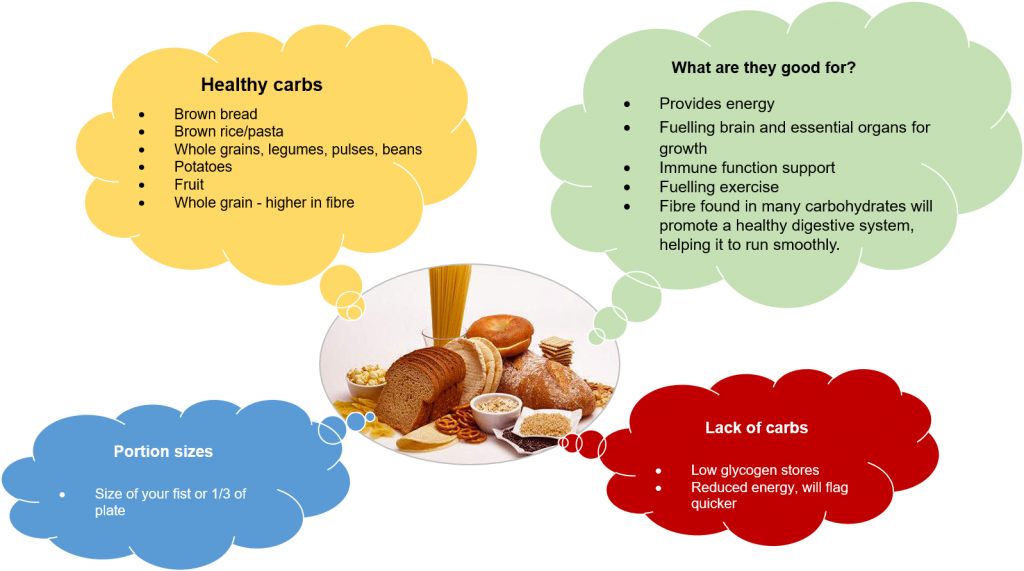
Starchy carbohydrates are a wonderful thing – they make us feel happy, satisfied and energetic, and quite simply, we need carbohydrates in our diet as they provide a large proportion of the energy we need to move our bodies, and the fuel our organs need to function.
WHAT ARE CARBOHYDRATES?
It’s important to recognise that not all carbs are equal – this is where I think the confusion lies. Carbohydrates are either sugars, starch that will eventually be broken down into glucose (a form of sugar) in the gut, or dietary fibre, which we can’t break down. So, it’s the type and how we consume them that has the most impact.
Foods that are rich in carbs fall into four main categories:
- – Simple sugars – white and brown sugar, honey, maple syrup
- – White complex carbohydrates – bread, pasta, rice, flour, cereal
- – Wholemeal and wholewheat complex carbohydrates – bread, pasta, rice, flour, cereal
- – Vegetables and fruit – root veg in particular, such as carrots, sweet potatoes, swede, turnips, parsnips
WHAT CARBS SHOULD WE BE EATING?
Simple carbs, such as white refined sugar or sugary processed foods and drinks, can be digested really quickly and are empty calories, giving us a blood sugar spike followed by an energy low that can leave us feeling sluggish. Eating more complex carbohydrates is key – they take longer to break down, are slow-releasing and give us a more sustained level of energy. Even better, choose wholemeal and wholewheat varieties, as these also contain more fibre and other nutrients that our bodies can use and take even longer to digest, helping to keep us feeling fuller for longer. I tend to trade up to wholemeal and wholewheat at least 7 times out of 10 – not only are you upping the nutritional value of what you’re eating, you’re also getting some really delicious flavours and textures and that drip-feed of energy is more useful.
Protein
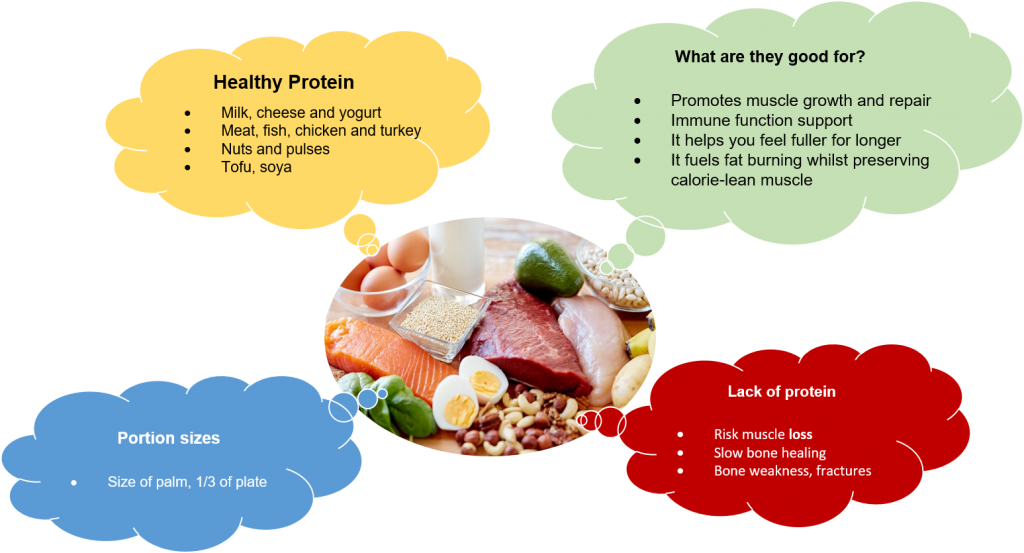
There are a lot of misconceptions about protein and its benefits, with some fad diets hailing it as the answer to everything. While protein is definitely an integral part of our diet, it does – like everything else – need to be eaten in the right amounts.
WHAT DOES PROTEIN DO?
Protein is the building blocks of our bodies. It is absolutely essential for the growth and repair of muscle tissue, as well as building hormones, enzymes that build and break down substances in our bodies, and antibodies in our immune systems. This list, as I’m sure you’ll recognise, is basically everything that’s important to how we grow, repair, feel, break down and absorb things, and how we fight disease and infections. Whether you’re a seasoned carnivore, a pescatarian, a veggie or a vegan, protein really is your best friend and should be enjoyed in the right way.
WHAT IS PROTEIN?
Basically, proteins are made up of a cocktail of 20 different amino acids. A lot are made in our body, but we have to get the rest from the food we eat.
Just like carbohydrates, not all protein sources are equal. Let me break it down:
- – Complete proteins – meat, fish, eggs, milk, cheese
- – Incomplete proteins – beans, nuts, seeds, lentils, cereals, quinoa, oats, peas, tofu, bread, flour, corn
That’s not to say that the complete sources are superior, they’re just different – think of them as a one-stop shop. What’s important is to eat a wide range of different proteins across the week, and that way you’ve got a really good chance of getting it right. You might have also heard the term ‘complementary proteins’. This refers to mixing up your incomplete protein sources with each other in order to build up your volume of amino acids – baked beans on toast or rice and peas are perfect examples of this.
HOW MUCH PROTEIN DO WE NEED?
About one-sixth of our balanced plate should be made up of protein. Your balance across a week in terms of meat and fish consumption should generally be at least two portions of fish, one of which should be oily (such as salmon, trout or mackerel), then you want to split the rest of the week between meat-free, poultry and a little red meat.
Dairy
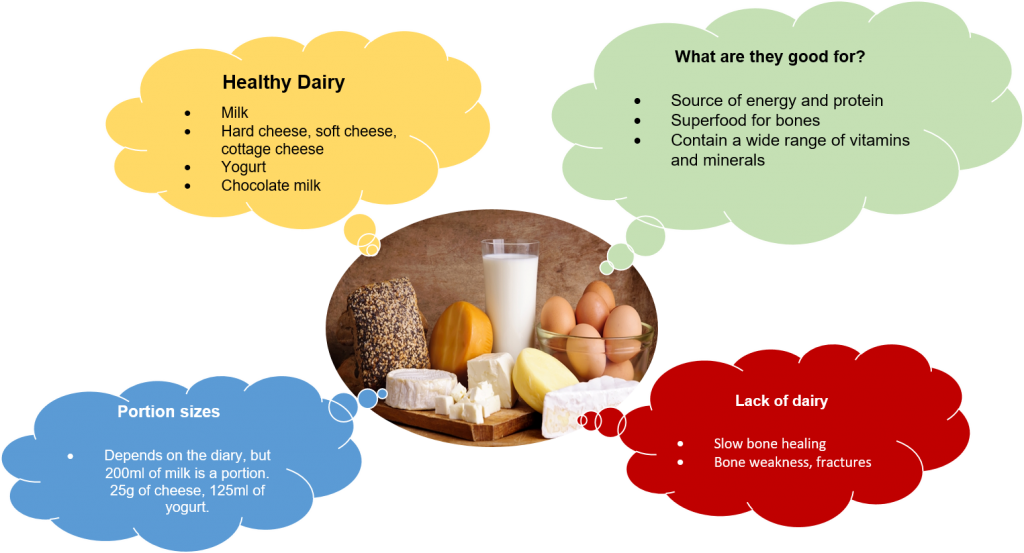
Unless you’re a vegan – this is a lovely area. Milk, yoghurt, cheese, butter, cream – yum! Though of course, it’s worth remembering that it’s milk, yoghurt and small amounts of cheese we should be favouring as the portion of dairy in our meals – butter and cream are very high in fat and saturated fat and don’t provide the full package of nutrients milk, yoghurt and cheese give us so, butter and cream don’t count towards our dairy portion.
WHAT IS DAIRY?
Produced primarily by cows, dairy products can also come from sheep, goats and even buffalo. Being just a small part of the balanced plate, around one-sixth of our meals should be made up of dairy.
EASY DAIRY CHOICES
Embracing the balanced-plate philosophy, you’ll find a little bit of dairy in the majority of meals in my new book. The easiest way to add dairy is to serve your meals with a dollop of yoghurt, or a little bit of cheese. As well as Parmesan and ricotta, you’ll see me using a lot of feta and cottage cheese because not only are they great carriers of flavour, but they can be used in really diverse ways and are much lower in fat than most other cheeses. If you’ve got a meal that doesn’t contain dairy, why not have a little glass of milk with or after it to supplement it, or have some yoghurt and fruit as a snack to get your balance back on track.
WHY DO WE NEED DAIRY?
It contains key nutrients to keep us stay strong and healthy:
- – Protein – crucial for growth and repair
- – Calcium – for strong bones and healthy teeth (especially during childhood and our teenage years, while our bones are still growing and developing)
- – Vitamin A – for good eye health (this is only found in dairy products that also contain fat)
- – Riboflavin – for healthy skin and helping us digest carbs (milk is the main source in our diets)
- – Iodine – helps to regulate our metabolism so our thyroid gland can function efficiently
Milk is incredible
It has a super-high nutrient density for most of the key nutrients and, in the grand scheme of things, is pretty low in fat. Milk is actually better at hydrating the body than water or sports drinks after exercise….and it comes in chocolate flavour!
ALTERNATIVES TO DAIRY MILK
Most alternative milks are fortified with calcium, B vitamins (including B12, which we can’t get from plant-based foods), vitamin D2 and E, to mirror the benefits of dairy milk. All those listed here are good for veggies and vegans, too. Choose unsweetened, when you can.
- – Organic soya milk – high in protein and low in sat fat, plus widely available, this is great for all-round use
- – Almond milk – subtly nutty and light in texture, this is great for breakfasts, such as pancakes, porridge and smoothies. It’s low in fat, sat fat and sugar
- – Hazelnut milk – with a wonderful nutty flavour this is perfect for smoothies and even baking
- – Oat milk – great for breakfast recipes and naturally low in fat and sat fat, mighty oats are proven to lower blood cholesterol if consumed regularly
Fruit and Vegetables
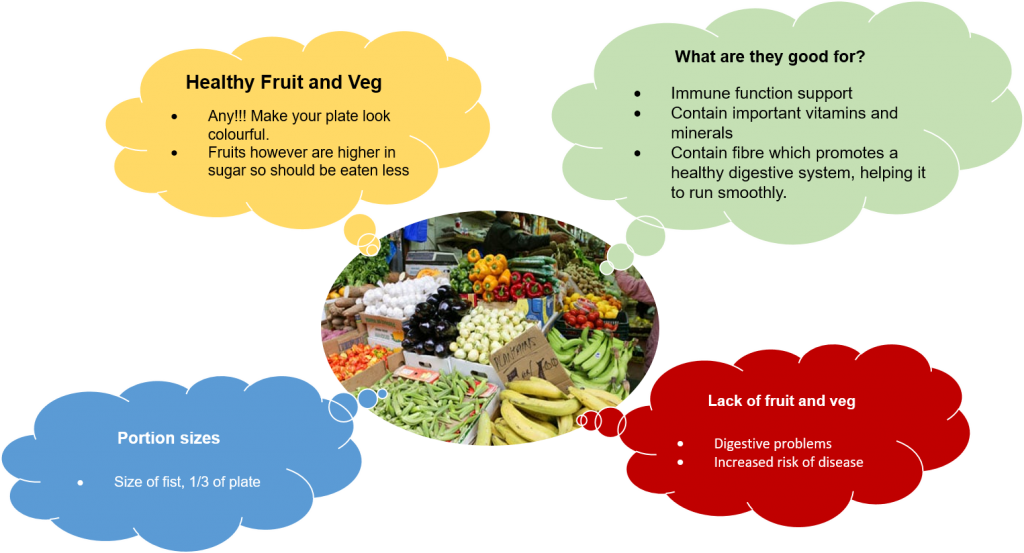
To live a good healthy life, veg and fruit need to be right at the heart of your diet. The wide bounty of incredible vitamins and minerals we get from the array of veg and fruit out there is honestly astounding.
You’ll notice I’m referring to veg and fruit, not fruit and veg. Fruit is brilliantly nutritious and we should definitely embrace it, but veggies shouldn’t be thought of as second best. Veg and fruit are at the core of the best diets in the world.
EAT THE RAINBOW
Veg and fruit come in all kinds of shapes, sizes, colours, flavours and textures, and help us to navigate the seasons in a wonderful way. There’s no denying their nutrient value, so the best thing we can do to take advantage of this nutritious bounty is to eat the rainbow, enjoying as wide a variety as possible.
HOW MUCH SHOULD WE EAT?
We’ve all heard about 5-a-day, but you should all be aiming for at least 5-a-day, ideally more. The reality is we should be trying to get seven or eight portions a day.
THE KNOWN HEALTH BENEFITS
Things we know for sure about these nutritional powerhouses are that veg and fruit can help us maintain a healthy weight and a healthy heart, as well as reducing the risk of strokes and some cancers. They are also packed with dietary fibre, keeping us regular (which is a good thing!) and helping reduce the risk of strokes and some cancers. They really should be embraced at every meal and they make great snacks, too.
THE UNKNOWN HEALTH BENEFITS
The brilliant thing about veg and fruit is that there’s loads of hidden stuff we’re yet to uncover too. For example, I can tell you that broccoli is high in folic acid and vitamin C, but nutritionists are looking at lots of other stuff on top of that, more nutrients, vitamins, minerals and trace elements that are beneficial to the body in many, many ways. S
Fats
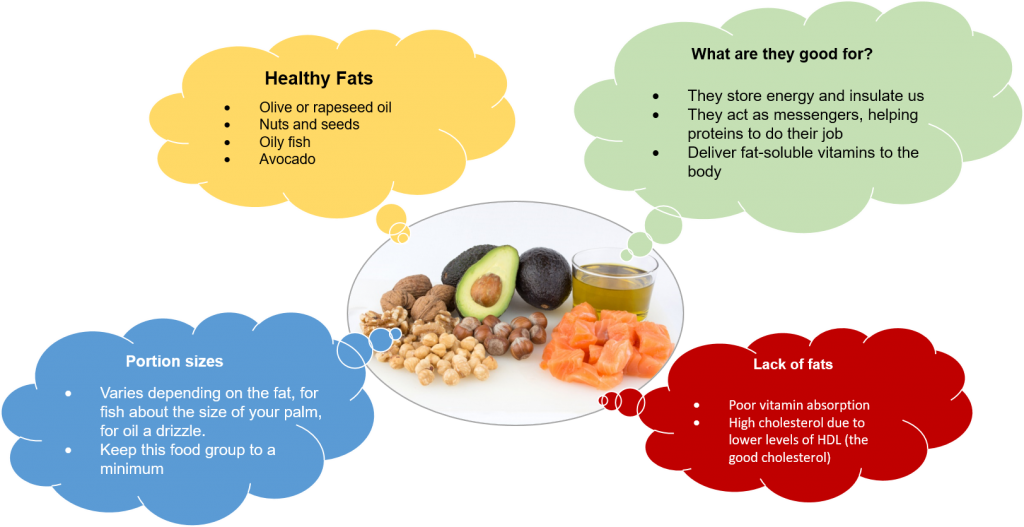
Let’s bust a myth right off – there’s no need to be afraid of fat, it’s not the enemy it’s been portrayed as.
Of course, our fat consumption needs to be controlled, at 9 calories per gram it’s the nutrient with the highest calorific value, but just because you eat fat doesn’t mean you’ll get fat. Fat is found naturally in our bodies and some fats we can only get from the food we eat, so it is an essential part of our diet – without it, we’ll die.
WHY DO WE NEED FAT?
Its main role is to provide energy, and fat is the way we store excess food energy. This is what allows us to draw on our reserves when food is in short supply – think of it as our natural battery. Adding fat to a meal is the most effective way of increasing the energy content – we also get energy from carbohydrates. What’s worth remembering is that if we are massively over-consuming fat, and our body doesn’t need that much, we will put on weight as our stores build up.
WHAT DOES FAT DO?
Fat provides insulation and protection to our internal organs, and a certain amount of body fat is needed to support fertility for all you ladies out there. What’s really crucial is that it supplies some fat-soluble vitamins and essential fatty acids, such as omega 3 and 6. In our weird and wonderful bodies many nutrients need the presence of fat to be properly absorbed. For example, having a little oil-based salad dressing is better than no dressing at all – it means we’re able to absorb more vitamin A, in the form of beta-carotene, from the veg.
TYPES OF FAT
- Unsaturated fats – these are generally the healthier type of fats to consume, where the dominant fatty acid is either monounsaturated or polyunsaturated. They’re found in olive oil and other liquid vegetable oils (see below), as well as nuts, legumes, avocados and omega-3 rich oily fish. Some oils help lower bad cholesterol and raise the good stuff – we like that
- Saturated fats – animal fats (butter, lard, suet, meat fat) tend to contain more saturated fatty acids, but also contain monounsaturated fatty acids. These fats are usually solid at room temperature. Because saturated fats raise cholesterol levels, we should be mindful of our consumption of them. They have also been linked with an increased risk of heart disease
HOW MUCH FAT DO WE NEED?
All fats should be eaten in moderation. In the UK, it’s recommended that the average woman gets no more than 70g of fat per day, with less than 20g of that from saturated fat, and the average man no more than 90g a day, with less than 30g coming from saturates.
THE HEALTHIEST OILS
One of the easiest ways to get good fats into your diet is to use a little oil in your cooking. Keep a range in your pantry for different purposes. Here’s my top five:
- Olive & extra virgin olive oil – super-high in omega 9, use cheaper, lighter olive oil for lower-temperature cooking, and save extra virgin olive oil for dressings and finishing.
- Rapeseed oil – a good source of omega 3, 6 and vitamin E, this contains half the saturated fat of olive oil.
- Walnut oil – a good source of omega 3 and 6, this oil is brilliant for dressings, marinades and finishing.
- Avocado oil – with the natural goodness of avocados, this is super-high in monounsaturated fats, omega 9 and vitamin E.
- Sunflower oil – an excellent source of omega 6 and vitamin E, this is a great, cheap oil.
OMEGA FATTY ACIDS
We need omega-6 fatty acids for many functions, including growth and development, and to maintain healthy skin – we generally get plenty of these in the diet. Omega-3 fatty acids are needed in smaller amounts to help keep our brains and hearts in tip-top condition, as well as helping to reduce our risk of heart attacks and strokes. Omega-3 sources are more limited – oily fish and vegetable oils are our best bet. Both of these essential polyunsaturated fatty acids can’t be made in the body, so we have to get them from food. We can, however, make omega-9 fatty acids in the body, but it’s still beneficial to use oils rich in them rather than saturated fats to help lower cholesterol and prevent heart attacks.